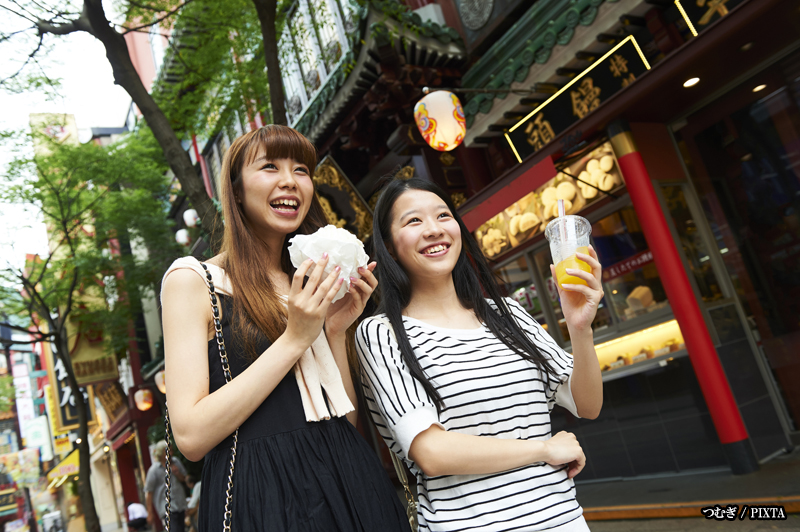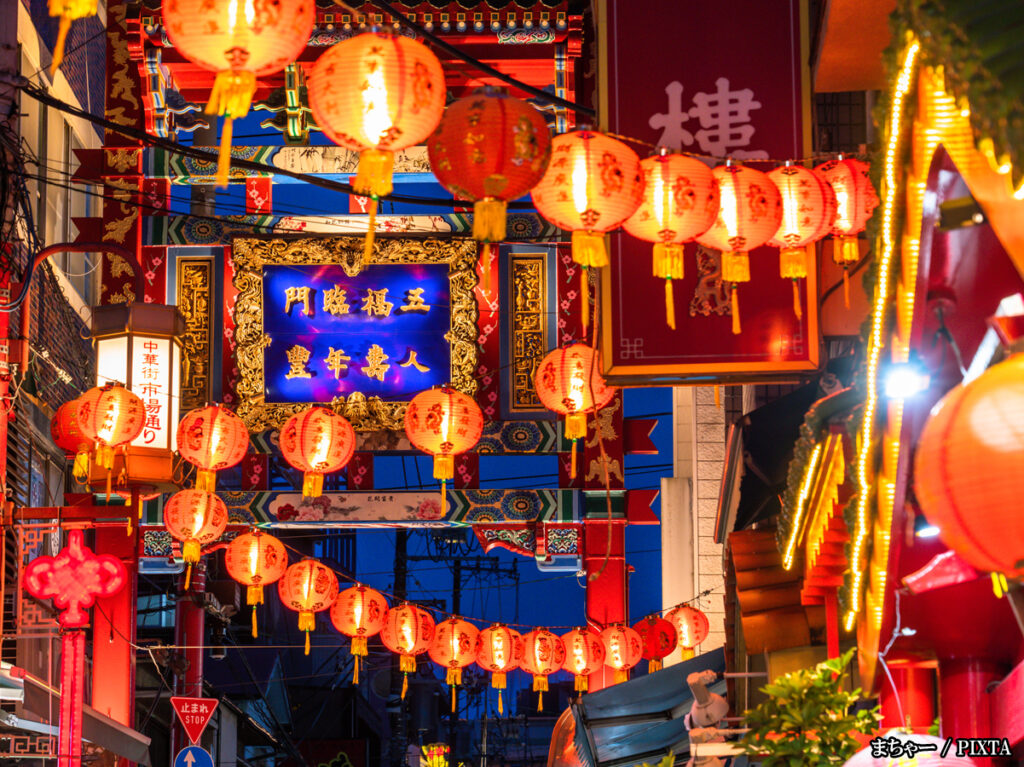Among Japan’s bustling Chinatowns, Yokohama Chinatown (Yokohama Chūkagai in Japanese) and Kobe Chinatown (Nankinmachi in Japanese, meaning ‘Nanjing Town’) reign supreme as the most celebrated, with Yokohama being the largest in the country and one of the oldest. Each showcases a vibrant fusion of Chinese heritage and Japanese urban life, featuring diverse cuisine, eclectic shops, and colorful architecture. When deciding which to visit, knowing the distinct vibe and standout features of each makes the choice much easier.
- Historical background and cultural influence
- Size and layout: Which is bigger and easier to explore?
- Food scene comparison: what to eat and where
- Events and festivals: seasonal highlights
- Accessibility and surrounding attractions
- Best for families, foodies, or culture buffs?
- Final thoughts: Choose based on your interests and travel route
Historical background and cultural influence
Yokohama Chinatown
- History: Established shortly after Yokohama Port opened in 1859, Yokohama Chinatown is Japan’s largest and one of the oldest. Chinese traders and immigrants settled here, building a lasting community. Over time, this long history has fostered a deeply entrenched and evolving Chinese culture within Japan.
- Cultural influence: Historically, Yokohama Chinatown has been a melting pot shaped by waves of immigration from various regions of China, including Guangdong and Shanghai, with a particularly strong Cantonese presence.
Kobe Chinatown
- History: Following the opening of Kobe Port in 1868, Kobe’s Chinatown took shape as Chinese immigrants arrived to work and trade locally. Despite suffering damage during World War II and the 1995 Great Hanshin Earthquake, the local community carefully rebuilt and revitalized the area.
- Cultural influence: Bearing the name of Nanjing (“Nankin” in Japanese), Kobe Chinatown retains ties to that region’s heritage. Its vibrant street food culture and glowing lanterns reflect a strong, close-knit community spirit.
Size and layout: Which is bigger and easier to explore?
Yokohama Chinatown
- Size: Covering several blocks, Yokohama Chinatown is vast, often described as a labyrinth of narrow streets and alleys, home to over 600 shops and restaurants. Its boundaries are marked by four elaborate gates positioned at the cardinal directions.
- Layout: The dense network of streets offers surprises around every corner but can feel overwhelming to first-time visitors. Exploring thoroughly requires time, and without a map or clear plan, it’s easy to get delightfully lost in its maze-like streets.
- Ease of exploration: Due to its size and complexity, navigating Yokohama Chinatown can be challenging for first-time visitors without a map or clear objective.
Kobe Chinatown
- Size: Much smaller and more compact, Kobe Chinatown centers around two main streets forming a cross, accompanied by a few smaller alleys.
- Layout: The straightforward layout easily guides visitors along main thoroughfares lined with stalls and shops, while decorative gates like the Chang’an Gate (Chōanmon in Japanese) at the east and the Xi’an Gate (Seianmon in Japanese) at the west add charm.
- Ease of exploration: Ideal for a casual stroll, Kobe Chinatown can be explored thoroughly in a short time, making it perfect for visitors looking for a quick but fulfilling visit.
Food scene comparison: what to eat and where
Yokohama Chinatown
- Variety and depth: Yokohama boasts an extensive and diverse food scene, ranging from casual street stalls selling nikuman (steamed pork buns), gyōza (pan-fried dumplings), and bubble tea, to upscale multi-story banquet halls offering authentic Cantonese, Shanghainese, Sichuan, and other regional Chinese cuisines.
- Dining experience: Visitors can enjoy everything from high-end dining and all-you-can-eat buffets to specialty shops, catering to both casual tasters and diners looking for a complete meal.
- Signature foods: Popular choices include nikuman, yaki-shōronpō (pan-fried soup dumplings), Peking duck, and a wide variety of dim sum (tenshin in Japanese).
Kobe Chinatown
- Street food focus: Nankinmachi is celebrated for its thriving street food scene. The atmosphere centers on quick, affordable bites from numerous stalls lining the main streets.
- Dining experience: While there are some sit-down restaurants, the joy of Nankinmachi lies in sampling snacks as you stroll through the neighborhood.
- Signature foods: Favorites include butaman (steamed pork buns), Chinese-style yakitori (grilled chicken skewers) and meat skewers, harumaki (spring rolls), as well as other savory bites perfect for eating on the go.

Photo for illustrative purposes
Events and festivals: seasonal highlights
Yokohama Chinatown
Famed for its grand Chinese New Year (or Lunar New Year) festivities, Yokohama hosts multi-day celebrations featuring lion and dragon dances, parade floats, martial arts demonstrations, and firecrackers that draw large crowds. Another notable event is Guan Yu Emperor’s birthday in July at the Kuan Ti Miao Temple (Kanteibyō in Japanese).
Kobe Chinatown
Though smaller in scale, Kobe’s Chinese New Year celebrations carry a warm, intimate atmosphere, featuring captivating lion dances and parades that illuminate the streets. The winter Rantan-sai (Lantern Festival) transforms the neighborhood into a glowing tapestry of colorful lanterns. Combined with the steady buzz of street food vendors, the area maintains a festive spirit year-round.
Accessibility and surrounding attractions
Yokohama Chinatown
- Accessibility: Visitors can reach Yokohama Chinatown from Tokyo via the JR Negishi Line to Ishikawachō Station (Chinatown Exit) or the Minatomirai Line to Motomachi-Chūkagai Station.
- Surrounding attractions: Located near Yokohama’s waterfront (close to the Minato Mirai area), it’s easy to combine a Chinatown visit with nearby sights such as Yamashita Park, Osanbashi Pier (which offers clear views of the city skyline), the Yokohama Red Brick Warehouse, the CupNoodles Museum, and the upscale Motomachi Shopping Street.
Kobe Chinatown
- Accessibility: Situated centrally in Kobe, Nankinmachi is a short walk from Motomachi Station (JR Kobe Line, Hanshin Main Line) or Kyūkyoryūchi-Daimarumae Station (Kobe Municipal Subway Kaigan Line), with easy access from Osaka or Kyoto via JR or Hankyu/Hanshin lines.
- Surrounding attractions: Nestled among Kobe’s main shopping areas, it’s close to landmarks like Kobe Port Tower, Meriken Park, the historic Kitano Ijinkan-gai (a district of Meiji-era foreign residences), and the bustling Sannomiya shopping district.

Photo for illustrative purposes
Best for families, foodies, or culture buffs?
Best for families
- Yokohama: Its larger size offers more space and variety, with nearby parks, museums, and family-friendly events at places like the Red Brick Warehouse. Although it can be crowded, these surrounding attractions provide ample activities for children.
- Kobe: More compact and easier to navigate, Kobe Chinatown suits younger kids well. Its street food scene also tends to appeal to children’s tastes.
Best for foodies
- Yokohama: Yokohama is known for its wide spectrum of regional Chinese cuisine, available in both casual and more formal dining settings.
- Kobe: Kobe’s Chinatown features many street vendors serving casual snacks and street food perfect for sampling on foot.
Best for culture buffs
- Yokohama: The cultural fabric of Yokohama’s Chinatown is woven through its distinctive gates, temples (like Kanteibyō), and annual festivals.
- Kobe: Kobe’s Chinatown, though smaller, presents a compelling narrative of resilience and rebuilding, evident in its intimate celebrations and enduring traditions.
Final thoughts: Choose based on your interests and travel route
Yokohama and Kobe showcase two sides of Chinatown life in Japan, each with its own appeal and atmosphere.
- Yokohama invites visitors to explore a sprawling neighborhood filled with varied dining options, busy shopping streets, and cultural festivals of significant scale. It’s well suited for travelers who have a full day to explore its many attractions and pair the visit with nearby sights.
- If you prefer a more intimate and manageable setting, Kobe offers a bustling street food scene within a compact area that’s simple to explore. It works well for shorter visits or as a stop within a broader Kobe city itinerary.
The Chinatown best for you depends on your interests and travel plans, but whichever you choose, you can expect an engaging journey through neighborhoods that have proudly upheld their cultural and gastronomic traditions for generations.

